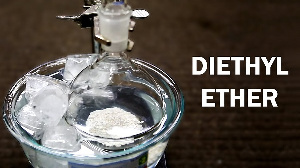 Importance of Diethyl ether
Importance of Diethyl ether
Dry ether: Why is it so important?
Dry ether is a compound that most of us call ether. Diethyl ether is most widely known for serving as an anesthetic and general-purpose solvent.
It is easy to see why this compound is so historically significant and how it has profoundly impacted the medical field. Ethers containing the ethyl group
Read full articleare widespread and found in many organic, industrial, and pharmaceutical compounds. This article will discuss the history of diethyl ether, its role in anesthesia. Diethyl ether is an organic compound widely used by industries to produce paints, varnish, linoleum, resins, and lacquers.
Properties of dry ether
Dry ether has a boiling point of 37.8 degrees Celsius and can be stored around 16 degrees Celsius for one year.
Dry ether evaporates quickly, making it great for creating quick, easily-accessible sealable containers such as leakproof syringes that do not leak no matter the pressure.
Its flammability worries some people, but this fear is unfounded mainly since diethyl ether is only combustible in oxygen and will not ignite without oxygen present as other flammable substances would.
Dry ether is a colorless, highly volatile, explosive liquid primarily used as an electronic fuel to clean surfaces.
It is also used as a solvent for oils, rubber, and asphalt. Diethyl Ether has no odor or flavor. Diethyl ether is an organic solvent, meaning it readily dissolves other substances. It has low toxicity in itself and is relatively nontoxic when it's in the air.
Diethyl ether vaporizes rapidly under normal atmospheric conditions, so it dissipates quickly. Ether, or diethyl ether, is an organic compound with the formula (C2H5)2O. It is highly volatile and flammable. The properties of this notably reduced alcohol have made it so valuable for chemistry and medicine. Chemists and physicians alike use it as a nonflammable solvent for many reactions that could be dangerous to work with otherwise.
Industrial Uses for Dry ether
One of the most valuable industrial uses for dry Ether is in the creation of foams for insulation. Foams are lighter in weight, more effective at blocking airborne sound, and more affordable than traditional fiberglass insulation.
Diethyl ether also has many other industrial uses. It's used, in some form or another, in the production of plastics like polyethylene; soleplates; cellophane; xerographic copiers; radial tires; perfumes; rubbing alcohols; paints; polystyrene foam sheets; furniture finishes like clear lacquer (such as amber shellac); alcohol preservatives, plasticizers for vinyl chloride-based compounds and laminates for PVC pipes.
Dry Ether is used to create solvents, paints, plastics, vinyl, and adhesives. These materials are often used for industries such as construction. Because diethyl ether evaporates quickly, it's commonly mistaken for being flammable. Though there are many industrial uses for diethyl ether, it can also be found as a natural flavoring agent in your home.
Ethyl Ether has many industrial uses that have increased its demand. For instance, it is often used as a thinner for varnish, lacquer, manufacturers' stains, and dyes. Another use is in making nitrocellulose - which is an explosive powder with unmatched stability. It can also use to make polymeric plasticizers.
Safety concerns
Diethyl ether, also known as "diethyl oxide" or simply "ether," is commonly used in labs and schools because it is relatively safe and fireproof. While it has the same inert properties as other diethyl replacements like methyl and ethyl ethers, diethyl ether still poses some dangers to consumers.
The other consequence is that diethyl ether can be oxidized. In particular, this behavior worsens in other oxidizing agents such as hydrogen peroxide, nitric oxide, and oxygen.
That creates a susceptible system where the slightest change in the needs of the reaction, while it is proceeding, will one way or another affect whether or not there is a buildup of explosive amounts of gas. The only real solution to any safety-associated problems is ensuring that nobody initiates any reactions involving diethyl ether. Diethyl ether (Ether) is a colorless, heavy, clear, volatile liquid with an odor like alcohol.
It is soluble in diethyl ether and organic solvents but not water. Diethyl ether is usually produced by reacting alcoholic ethanol gas with sulfuric acid, chlorine, or some other acid. Many countries restrict diethyl ether for safety reasons because it's explosive in a concentration above 75%.
Chemotherapy with Diethyl ether
Diethyl ether is an organic solvent that dissolves other chemicals, making it helpful in preparing medicines, cleaning parts of machinery, or melting points. Aside from these efficient purposes, diethyl ether also has some unusual side effects. For around two decades until around 1900, diethyl ether was used to carry out surgeries. Chemotherapy using this chemical was developed in the early 20th century by French doctor Jean-Martin Charcot and German physician Max Neisser.
Tesla has rolled out various safety measures since it began manufacturing cars. The first notable safety feature is the front-mounted radar that allows the Diethyl ether has been used in the past to induce deep anesthesia for surgery. From about 1920-1960, braziers burned diethyl ether on the floor of operating rooms while doctors operated on patients. It is an unnecessary alternative to modern methods like sedatives and conscious sedation, which employ drugs, not open flames.
Conclusions
In conclusion, the gas diethyl ether has been a handy tool that continues to be developed and improved to this day. It is a universally used hemostatic agent in many surgical settings due to its low toxicity and the ease with which it diffuses into tissue.
Dry Ether is a colorless, volatile liquid. It is usually sold in bottles with an eyedropper to help measure doses because the consistency of the liquid makes it difficult to measure by volume. Not only is it flammable, but also many chemicals are combustible if they come into contact with it.
That includes water, alcohols, acetones, alkalies, other alkenes, propane gas, turpentine oil, dilute acetic acid, esters, and gasoline. Diethyl ether should be stored in glass containers with mark gradations to keep track of its level. Diethyl Ether is an organic compound that has a variety of applications. Diethyl ether was the first anesthetic used for operations. It is also used in paint thinners, fuel systems of rice torches, laxatives, and needle-free injections of drugs.
Although the discovery of dry ether came to public awareness in 1818, more research on this topic will continue to be done to use it correctly in various areas.











